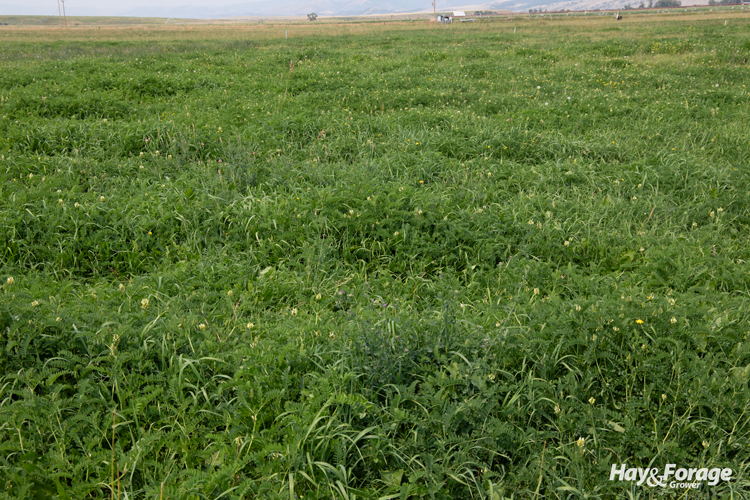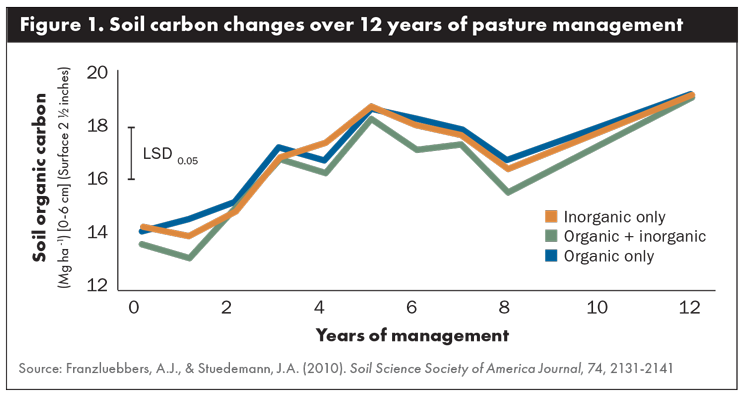
Do fresh, newly planted pastures provide better nutritional quality for grazing livestock than older pastures? Are pastures worn out with age? How old is old enough for an effective pasture on your farm? Do pastures need to be renovated because they’ve served several generations of brood cows?
Some of these questions can be rationally answered and acted upon, while others may require an epiphany, or maybe just random action.
Long-term research trials comparing pasture management strategies are rare in the U.S. Such trials require dedicated investments of time, labor, and inputs. One of these trials was conducted in northern Georgia during the 1990s and 2000s. Russell Bruce, John Stuedemann, and Stanley Wilkinson initiated a Coastal bermudagrass study to compare the effects of forage utilization and nitrogen fertilization on cattle productivity, forage production and quality, and soil health.
In the study, forage was managed along a gradient from not utilized (simulates conservation reserve) to grazed lightly to grazed intensively to harvested frequently for hay. Nitrogen input treatments were inorganic nitrogen only, crimson clover cover crop plus reduced inorganic nitrogen fertilizer, or poultry litter only. After five years of observations, management systems were changed in some of the treatments. Additional observations were made over the next seven years when Georgia-5 tall fescue was successfully overseeded into the bermudagrass sod. Many useful results were produced from the trial, and it took a football team-sized effort to get it all done.
Better with age
Nutrients: With nearly annual sampling over a dozen years of management, we found that phosphorus, potassium, manganese, zinc, and copper levels increased in soil to almost double initial values or greater. The requirement for lime with high inorganic nitrogen fertilization levels led to elevated calcium and magnesium levels. Grazing of forage and return of feces to the land led to higher soil potassium while haying caused a decline in soil potassium due to forage removal.
Soil phosphorus accumulated noticeably to a 5-inch depth during the first five years when fertilized with poultry litter. Significant lateral redistribution of phosphorus also occurred, with shade and water areas having greater soil phosphorus levels than farther away.

Soil organic matter: Soil organic matter is typically measured from the amount of carbon in a soil sample. Soil organic matter contains 58% carbon. Over time, soil organic carbon increased in all pastures. The rate of change was faster during the first five years and slower during the next seven years. However, this result was not necessarily due to differences in botanical composition or treatment changes, but more likely due to a three-year drought that limited forage production but kept soil microorganisms from decomposing.
There was a loss of soil carbon that occurred during years 6, 7, and 8. Because this experiment was terminated at the end of 12 years due to funding limitations, we don’t know if soil organic carbon would have rose further or would have stabilized in balance between carbon inputs and outputs.
On average, soil organic carbon accumulated at a rate of 0.48 metric tons (MT) of carbon dioxide (CO2) per acre per year when left unharvested as conservation reserve, 0.93 MT of CO2 per acre per year when grazed lightly, 0.89 MT of CO2 per acre per year when grazed intensively, and 0.11 MT of CO2 per acre per year when hayed frequently. Grazing pastures was highly beneficial for soil organic matter accumulation! Hay removal was placing carbon into a cattle diet elsewhere on the farm and not returning carbon contained in feces back to the hay ground.
Nitrogen cycling: Organic nitrogen increased during the 12-year period at rates of 27, 63, 68, and 7 pounds per acre per year when unharvested, grazed lightly, grazed intensively, or hayed frequently, respectively. While fertilizing with nitrogen aimed to improve forage growth and quality, it was also reinvesting in soil fertility that could help pastures remain productive over time.
Other approaches to getting reasonable and reliable estimates of soil organic carbon and nitrogen accumulation will be explored in a future issue. Until then, consider whether your pastures are too old or just right.
This article appeared in the March 2024 issue of Hay & Forage Grower on page 14.
Not a subscriber? Click to get the print magazine.

